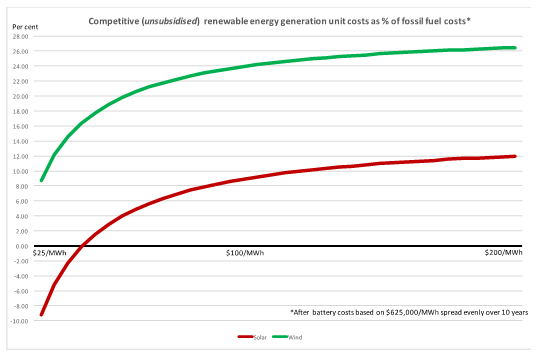For the last two conclusions, I assumed 2016-17 AEMO 'efficiency' ratings (from SA) of 29% for wind power and 15% for solar power. Elsewhere in Australia, on average, these 'efficiency' estimates could be lower.
I've not allowed for 'unused' or 'curtailed supply' power (see my previous opinion piece). I've not allowed for costs of insuring against renewables uncertainty given their intermittent supply. Dealing with the first of these (adding more batteries) can sometimes lower renewables power costs (net). But adding more batteries delivers such savings at higher power costs. At reduced costs, savings are smaller or negative. Insuring against uncertainty (adding generation and storage capacity) raises costs both for wind and solar.
What unsubsidised renewables unit costs would make them cost-competitive against fossil fuels? Do a 'what if', using the $625,000/MWh cost of Victorian batteries and the 2016-17 AEMO SA results for wind and solar 'efficiency' (29% and 15%, respectively). There are many scenarios. Assume a very wide range of fossil fuel costs, from, say, $60/MWh to $200/MWh, for comparison. In summary (also see chart below):
Advertisement
- Renewables cop multiplied power storage. This 'fixed $ cost', as a %, declines as power costs rise.
- Intermittency also multiplies required renewables generation capacity to deliver the same power, 24/7.
- Competitiveness requires wind generation unit costs to be around 20%-27% of fossil fuels, or less.
- Competitiveness requires solar generation unit costs to be around 5%-12% of fossil fuels, or less.

- Even with $200/MWh fossil fuels, wind and solar must be below $53/MWh and $24/MWh, respectively.
- If fossil fuel costs are in the range $60-$200/MWh, 'new' coal (including HELE) is cheaper, unless the matching wind cost range is less than $12-$53/MWh, or solar generation costs less than $3-$24/MWh.
- If 'old coal' costs $40/MWh, solar generation, after battery costs, must be free to compete. If batteries are free, competitive renewables must cost under 29% (wind) or 15% (solar) of the cost of fossil fuels
- Shifting further to reliance on renewables-fuelled power increases average power costs.
The Australian power user has been assaulted by battery fever. This fever is a complication from cost and reliability consequences of an earlier renewables fever contracted by politicians and passed on to the grid. These maladies now feed on each other. I gather the justification for one NT battery project is as follows:
'he government-owned utility Territory Generation wants the battery to provide contingency frequency control ancillary services (FCAS), reduce the required spinning reserve from its various gas and diesel generators, provide peak shaving and ultimately allow for more solar PV in the local grid.'[Emphasis added]
'Autumnal Cannibalism' is a 1936 painting by Salvador Dali. I think about it in Australia today. In energy policy, and other areas, we seem to be feeding on each other.
Advertisement
As we chew away our efficiency, productivity, and international competitiveness, we might consider policy 'own goals' gnawing at our living standards. Our energy policy's a ball we've blithely kicked into our own net. Affordable power's a receding vision and fond memory, political assertions to the contrary notwithstanding.
Put all this in context. Australia's 1.3% global emissions share is falling as others increase theirs. Alone, can our renewables (or other emissions reduction) efforts deliver even a zero reduction globally? No.
In the Tower of Babel that is our energy policy debate (sic) today, it seems that's an inconvenient answer.
Discuss in our Forums
See what other readers are saying about this article!
Click here to read & post comments.
17 posts so far.